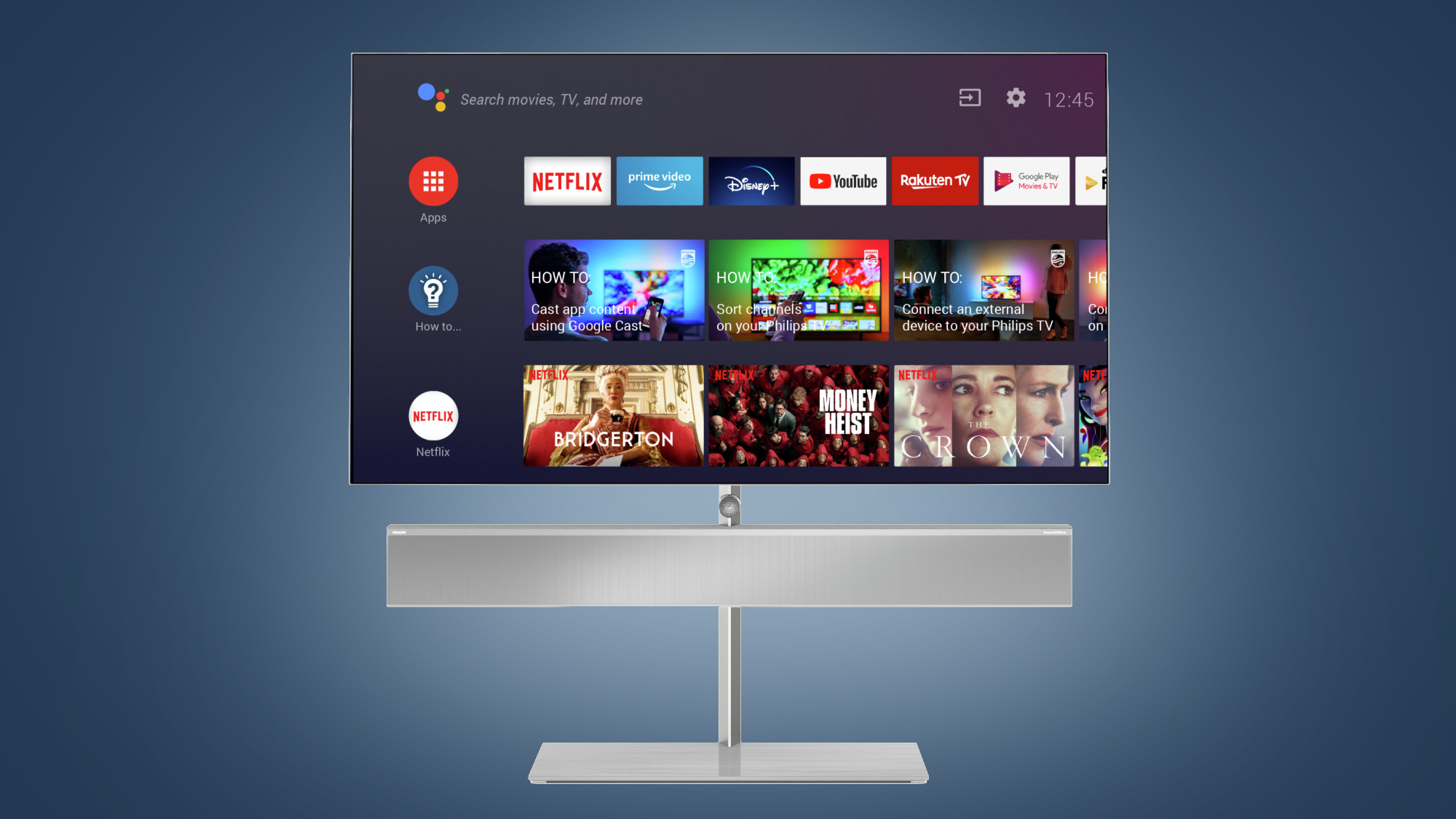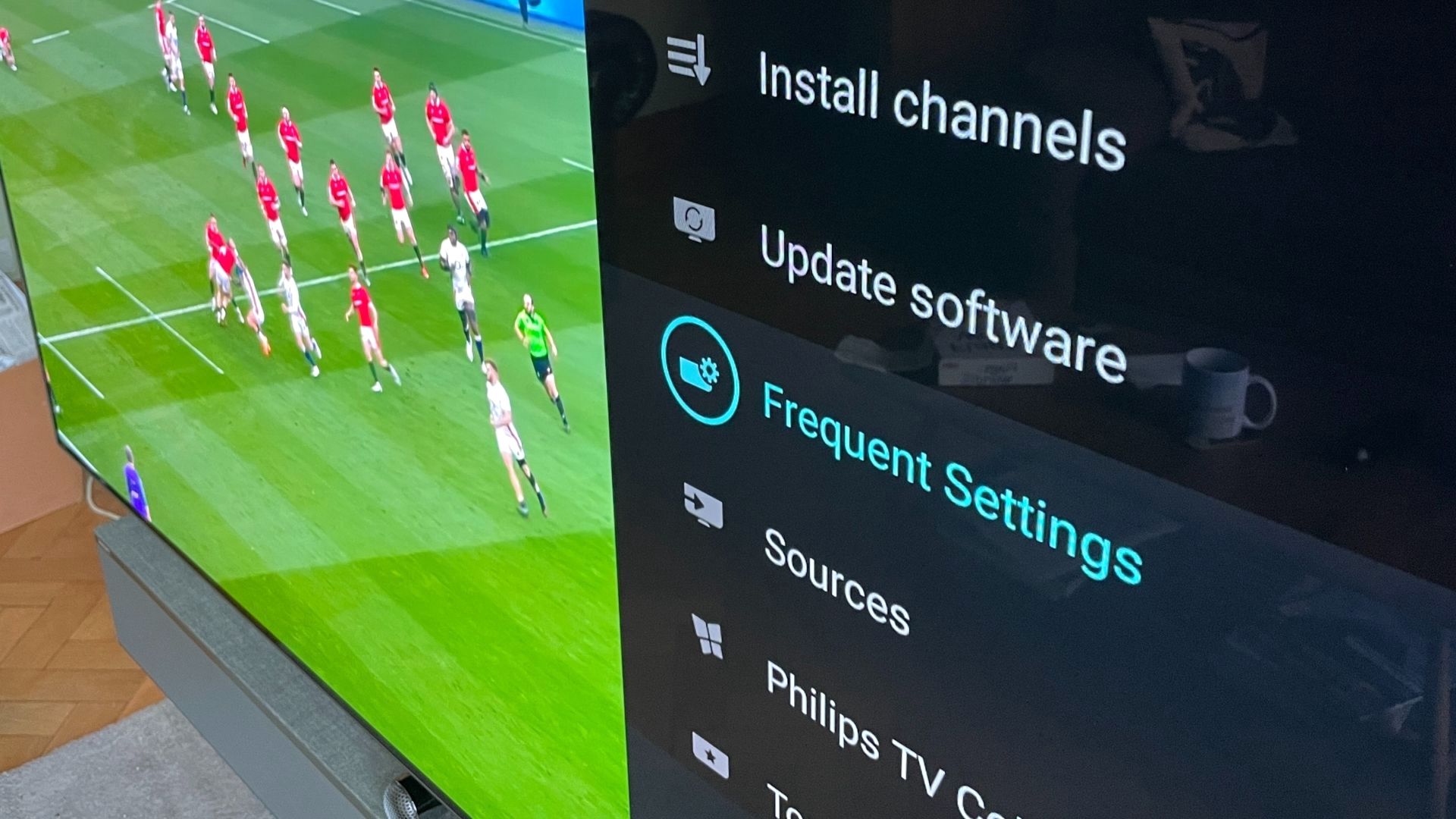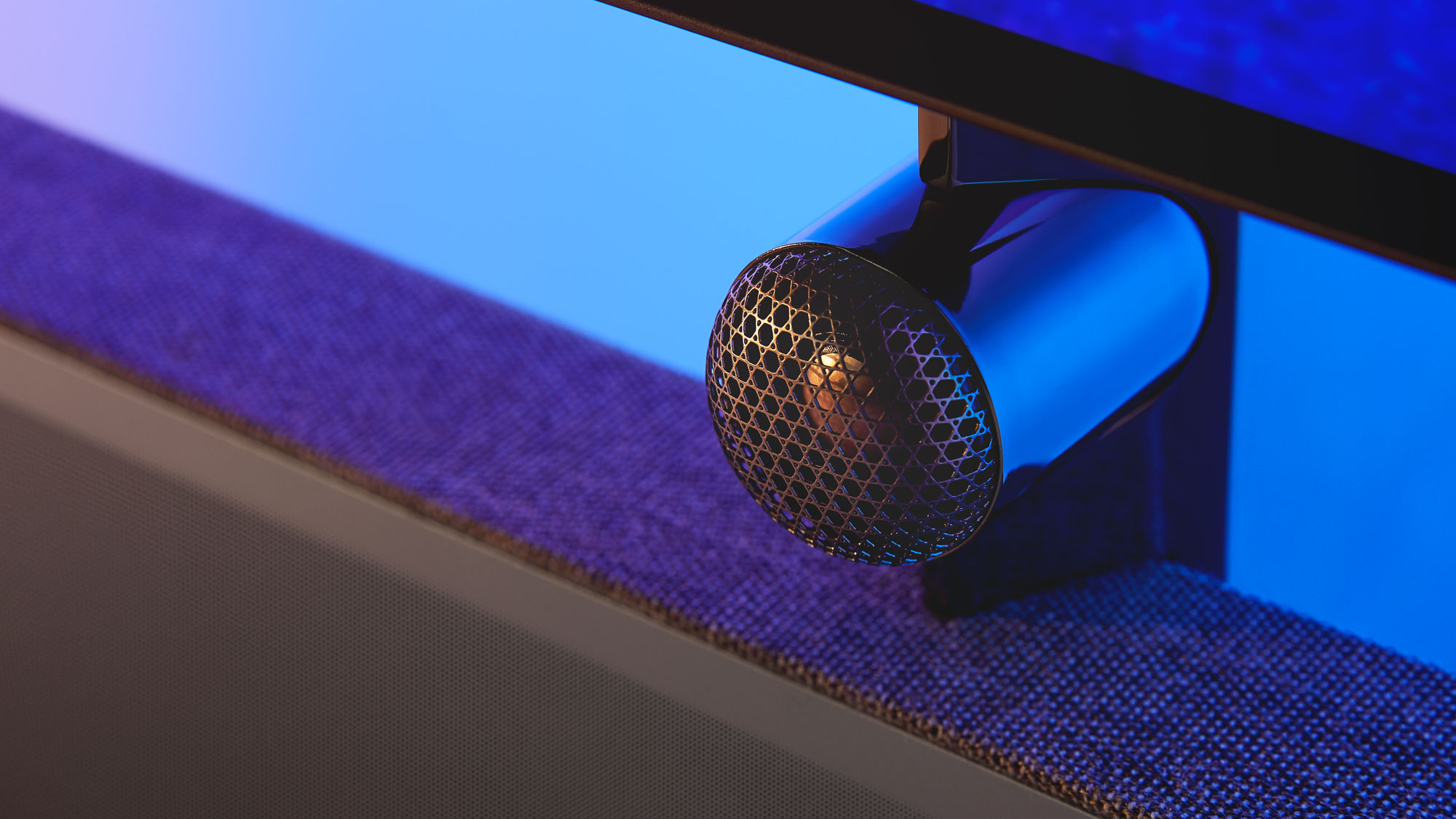TechRadar Verdict
Those after a statement TV that impresses both on picture and sound should look no further than this unique all-in-one OLED TV that adds four-sided Ambilight to push immersion to the max.
Pros
- +
Colour, brightness, contrast and sharpness
- +
Spectacular floorstander speaker stand design
- +
Hi-fi sound system
- +
Leather-clad backlit remote control
Cons
- -
No Dolby Atmos height channels
- -
Remote lacks shortcuts
- -
Needs time to set up
- -
Very expensive
Why you can trust TechRadar
One minute review
Who needs a Bang & Olufsen TV when you’ve got a Philips flagship OLED TV right in front of you? A 65-inch behemoth available only in one size, the OLED+986 is a heavyweight TV in many more ways than one.
Screen Size: 65-inch | 4K: Yes | HDR10: Yes | HLG: Yes | Dolby Vision/Atmos: Yes/No | Panel technology: OLED | Smart TV: Android TV 10 | Curved: No | 3D: No | Inputs: 2x HDMI 2.1 (1x eArc, 2x HDMI VRR), 2x HDMI 2.0 | 3x USB, RF, satellite, ethernet | Outputs: optical, subwoofer, headphones
Taking top billing has to be its OLED panel, which smoothly delivers all flavours of HDR (HDR10, HDR10+ Adaptive, HLG and Dolby Vision) with exceptional contrast, black levels, detail and colour. Noticeably brighter across the entire screen compared to previous iterations of OLED – and excellent colour, brightness, contrast and sharpness – the only blot in the OLED+986’s copybook is a slightly convoluted onscreen user interface to access picture settings. We would also like to see more shortcuts on the remote to more easily and quickly tinker with picture settings (something that is necessary on the OLED+986 to get the very best out of it).
Aside from its picture prowess, the OLED+986’s speaker stand is exemplary. Manufactured by Bowers & Wilkins, the 70W unit pumps out high-octane movie soundtracks and complex music both loudly and with impeccable balance. The TV is understandably expensive, but with the OLED+986 you’re paying for a statement TV that leaves an impression – and the immersive four-sided Ambilight seals the deal - even if it’s designed to max-out if the OLED+986 is mounted on a wall.

Price and release date
- Selling for around £3,999
- Announced in October 2021, but now widely available
- Philips’ flagship OLED TV
Although the OLED+986 was first announced back in October 2021, delays have meant that it’s been difficult to get hold of until now. Now on sale, the OLED+986 is available only in the 65-inch 65OLED986/12 variant and sells for around the £3,999 mark.
Design
- Floorstander speaker stand
- Four-sided Ambilight TV
- Weighs 37.5kg
The OLED+986 is simply a thing of beauty. It’s mounted on a brushed stainless steel stand that, happily, has a cable-tidy built into it so you can install it with clean lines. It matters where you position it because, firstly, it has four-sided Ambilight – Philips’ unique lighting-boas tech that dynamically mirrors the colours you see on-screen – but you'll only get the most out of it if you position it close to a wall, or wall-mount the telly.
Then, the strips of LEDs on the back can do their thing (they can also rope in any Hue lights you happen to have in the room for an even more immersive display). A second reason why you’ll want to think about positioning is because the OLED+986 is both very, very heavy and takes a while to physically put together. At this price, though, we'd advise the TV to be installed by a professional.
The Bowers & Wilkins speaker is part of the stand, but the portion below is detachable, making the OLED+986 theoretically able to hang on a wall. It’s not a separate soundbar, though; a proprietary cable connects it to the back of the OLED+986.
Sign up for breaking news, reviews, opinion, top tech deals, and more.
On the back are all the ins and outs you might expect, with the highlight being four HDMI inputs. That haul includes two HDMI 2.1 slots that can handle 4K at 120 Hz for games, complete with Freesync Premium (comprising auto low latency mode (ALLM) and variable refresh rate (VRR) tech). However, gaming content is then downscaled to half the resolution.
Long and sleek, the remote control provided with the OLED+986 very much matches the high-end design theme, with a leather-clad backplate and a nicely backlit control panel. It’s home to a few shortcuts to streaming apps, though UK users will likely be slightly surprised to see Rakuten TV (a popular streaming app across Europe), something that also appears on LG TV remote controls.

Smart TV (Android TV)
- Android 10
- Amazon Prime, Netflix, Disney Plus, YouTube and Apple TV
- Rakuten TV gets its own shortcut
It may be slightly outdated, but the Android TV 10 operating system on the OLED+986 looks great and is stuffed with apps out of the box. There’s a central hub of apps already downloaded to the TV that you can customise in terms of where they appear – if at all – on the home page. That’s good news because there are some apps, notably Rakuten TV and Red Bull TV, that are wildly popular in some regions and almost unheard of in others (such as Rakuten TV).
Sign in to a Google account and you’ll be able to download apps from the Google Play Store for Android TV to the OLED+986’s 16GB of storage, though built-in apps are plentiful enough for most users. Catchup TV apps in the UK include BBC iPlayer, ITV Hub, All 4, My5 and UKTV while streaming apps comprise Amazon Prime Video, Disney Plus, Google Play, Netflix and YouTube. All deal in 4K and HDR, subscriptions allowing. You’ll also find Spotify and BBC Sounds in the list of built-in apps.
The OLED+986 includes a lot of 'content discovery;' scroll down the main screen and you’ll see suggestions – as thumbnails – of recommended shows within the catch-up and all the best streaming apps you’ve signed into.
Android TV 10 works well, though it’s not completely joined-up to the OLED+986’s own internal menu systems. For example, while it’s possible to fiddle with picture, sound and Ambilight settings to your heart’s content while watching Disney Plus, try doing the same while using the BBC iPlayer and BBC Sounds and you’ll immediately find yourself back on the home screen. There are clearly some small issues to resolve, though the OLED+986’s user interface is always extremely quick.

Picture quality
- P5 AI perfect picture engine
- Supports HDR10, HDR10+ Adaptive, HLG and Dolby Vision
- Bright and colourful with excellent black levels
The OLED+986’s picture quality is outstanding. It uses the same brighter OLED panel found in LG’s Gallery Series, but as with a lot of Philips TV there are myriad processing options within the OLED+986’s image engine, in this case the all-new dual-chip P5.
The OLED+986 boasts exceptional contrast because, like all OLED TVs, its pixels can be individually lit or dimmed. It’s also able to produce outstanding contrast even within tiny areas of the screen. For example, the glint in an eye – literally a momentary shine detected in the eye of an actor – is reproduced exquisitely despite much of the surrounding image being dark and shadowy. Wow! That effect shines brightest on Dolby Vision Bright mode, Philips’ own tweaked version of Dolby Vision, which brightens and slightly sharpens HDR images, but leaves the colour untouched (Dolby Vision Dark, which represents the original parameters, is also provided on the OLED+986).
TV show Jack Ryan, in Dolby Vision on Amazon Prime, a ceiling fan whizzes in slow motion and the OLED+986 produces it cleanly while that same skill delivers detailed image after detailed image during ponderous camera pans and high-octane action sequences.
On non-Dolby Vision HDR fare the HDR Home Cinema preset impresses, with no obvious advantages from using the set’s Colour Enhancement, Ultra Resolution or Perfect Natural Reality modes, though Light Boost brings a little more brightness and detail to black areas. So does switching off the Light Sensor if you watch in a blackout.
If anything the OLED+986 is just too inky black in some sense, with some areas of black objects – such as walls, suits and exceptionally dark exterior shots – suffering a little crushing. However, the OLED+986’s inky blackness routinely lifts the image into new levels of realism.
Using the OLED+986 with a Virgin Media set-top box revealed the OLED+986 to be superb at upscaling; a feed from ITV of an England Vs Wales Six Nations match was bold, colourful and clean, with very little noise, blocking or motion issues.
Do OLED TVs suffer from screen burn? We’re still not convinced by that argument, but it persists so Philips has the P5 image chip’s anti-burn system cycle through refreshing the screen in 32,400 individual zones to prevent any chance of image retention. It does that intelligently, dimming logos on purpose, though during our review we didn’t notice it.
Audio
- 70W Bowers & Wilkins speaker stand
- Virtualises height channels for Dolby Atmos
- Hugely impressive with movies and music
Have you ever heard of a TV that can deliver a bass-heavy movie soundtrack with flare, detail and dynamism? You have now. The Bowers & Wilkins speaker stand, a built-in speaker enclosure with a 3.0 array is totally unique in the TV world. So, too, is its iconic design that sees its centre channel tweeter perched above it.
It goes loud – insanely loud – without a trace of distortion while pushing a powerful soundstage into the room. It’s got incredible depth for a TV speaker, with plenty of bass response and sharp treble highs that lend movie soundtracks – including Dolby Atmos (though it lacks upfiring speakers to virtualize height channels), Dolby Digital and DTS-HD (M6) – an all-over powerful presence.
It’s arguably even better with music. The driving bass line in Come Together by The Beatles in spectacular stereo proves almost ridiculously impactful for a TV while some complicated electronic music from Kraftwerk showcases its skill with fine treble details.
Should I buy the Philips OLED+986 4K HDR OLED TV?

Buy it if...
You usually buy Bang & Olufsen TVs
The OLED+986’s combination of brushed stainless steel, a fabric-covered speaker and a floating speaker stand design make it a statement TV, with Ambilight sealing the deal for anyone after something unique.
You adore Ambilight
It’s said by some – mainly Philips – that watching TV with bias-lighting around it can lessen eye strain and increase perceived contrast. Ambilight, strips of LEDs on the back of the TV, cover the walls of your living space with colours that match those on screen. It’s presented here in its maximum four-sided flavour.
You need an awesome hi-fi
Given that the OLED panel inside the OLED+986 is available slightly further down the Philips food chain in its OLED+936 Series, arguably one of the main reasons to choose the OLED+986 is its fabulous, flawless Bowers & Wilkins speaker stand.
Don't buy it if...
Money is tight
Obviously the price tag being asked by Philips for the OLED+986 isn’t just for the hardware on offer, but rather the design. The OLED panel inside the OLED+986 is the same as that found on the step-down OLED+936 Series.
You’ve already got a surround sound system
The 70W speaker stand is almost flawless compared to any other TV we’ve ever listened to, but it’s still going to prove an expensive luxury if you already have a surround sound set-up.
You’re obsessed with Dolby Atmos
Although its speaker stand virtualises height channels, it's not natively a Dolby Atmos-compatible since it lacks dedicated upfiring speakers.

Jamie is a freelance tech, travel and space journalist based in the UK. He’s been writing regularly for Techradar since it was launched in 2008 and also writes regularly for Forbes, The Telegraph, the South China Morning Post, Sky & Telescope and the Sky At Night magazine as well as other Future titles T3, Digital Camera World, All About Space and Space.com. He also edits two of his own websites, TravGear.com and WhenIsTheNextEclipse.com that reflect his obsession with travel gear and solar eclipse travel. He is the author of A Stargazing Program For Beginners (Springer, 2015),
